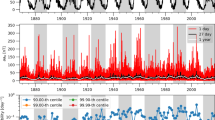Abstract
The possibility of advance tornado warning is analyzed. The tornado observed in Bashkortostan on August 29, 2014 is considered as an example. To compute meteorological fields, the WRF model with high spatiotemporal resolution is used. Indices of convective instability are calculated. The analysis of variations in indices enabled forecasting the tornado generation with the lead time up to three days and with the accuracy up to several hours in time and 200 km in space. The possibility is demonstrated of registering and nowcasting tornados by using the available software for radar data processing. The polential is discussed of the joint use of such information for developing the syslem of monitoring and forecasting of severe weather events including tornados.
Similar content being viewed by others
References
I. M. Gubenko and K. G. Rubinshtein, “An Example of the Comparison of Middle Troposphere Instability Indices in the Prognostic Model with the Thunderstorm Activity Data,” Meteorol. Gidrol., No. 5 (2014) [Russ. Meteorol. Hydrol., No. 5, 39 (2014)].
M. V. Kurganskii, A. V. Chernokul’skii, and I. I. Mokhov, “The Tornado over Khanty-Mansiysk: An Exception or a Symptom?”, Meteorol. Gidrol., No. 8 (2013) [Russ. Meteorol. Hydrol., No. 8, 38 (2013)].
M. A. Novitskii, B. Ya. Shmerlin, S. A. Petrichenko, et al., “Using the Indices of Convective Instability and Meteorological Parameters for Analyzing the Tornado-risk Conditions in Obninsk on May 23, 2013,” Meteorol. Gidrol., No. 2 (2015) [Russ. Meteorol. Hydrol., No. 2, 40 (2015)].
System-wide Solution on Acquisition, Control, and Presentation of DMRL-C Radar Data. Technical Project (Roshydromet, Moscow, 2014), http://meteorad.ru/static/TP-DMRL-2014.pdf.
N. P. Shakina, Lectures on Dynamic Meteorology (TRIADA LTD, Moscow, 2013) [in Russian].
ARW Version 3 Modeling System User’s Guide, July 2012, http://www.mmm.ucar.edu/wr#users.
B. Bluestein Howard, Severe Convective Storms and Tornadoes. Observations and Dynamics (Springer-Verlag, Berlin, Heidelberg, 2013).
R. Davies-Jones, D. Burgess, and M. Foster, “Test of Helicity as a Tornado Forecast Parameter,” in Preprints of 16th Conference on Severe Local Storms, Kananaskis Park, AB, Canada (Amer. Meteorol. Soc., 1990).
C. A. Doswell and D. M. Shultz, “On the Use of Indices and Parameters in Forecasting Severe Storms,” Electronic J. Severe Storms Meteorol., No. 3, 1 (2006).
J. A. Hart and W. Korotky, The SHARP Workstation v1.50 Users Guide (National Weather Service, NOAA, U.S. De partment of Commerce, 1991).
D. Leuenberger, M. Stoll, and A. Roches, Description of Some Convective Indices Implemented in the COSMO Model, Consortium for Small-Scale Modelling COSMO Technical Reports, No. 17 (2010), www.cosmo-model. org.
NOAA National Operational Model Archive & Distribution System, http://nomads.ncdc.noaa.gov/data/gfs4/201407/20140715/.
NOAA Tornadoes 101, http://www.noaa.gov/features/protecting/tornados101.html.
M. A. Novitskii, B. Ya. Shmerlin, S. A. Petrichenko, et al., “Using the Indices of Convective Instability for Analyzing and Forecasting Tornado-risk Situations,” in Fluxes and Structures in Fluids: Proceedings of International Conference; June 23-26, 2015, Kaliningrad (MAKS Press, Moscow, 2015).
The Global Forecast System (GFS)-Global Spectral Model (GSM), http://www.emc.ncep.noaa.gov/GFS/doc.php.
R. L. Thompson, R. Edwards, J. A. Hart, et al., “Close Proximity Soundings within Supercell Environments Obtained from the Rapid Update Cycle,” Weather and Forecasting, 18 (2003).
University of Wyoming. Atmospheric Soundings, http://weather.uwyo.edu/upperair/sounding.html.
Weather & Aviation Page. Storm Indices. EBBR BRU Brussels Aircraft Communications Addressing and Reporting System, http://www.skystef.be/storm-indices.htm.
M. L. Weisman and J. B. Klemp, “The Dependence of Numerically Simutated Convective Storms on Vertical Wind Shear and Buoyancy,” Mon. Wea. Rev., 110 (1982).
Author information
Authors and Affiliations
Corresponding author
Additional information
Original Russian Text © M.A. Novitskii, Yu.B. Pavlyukov, B. Ya. Shmerlin, S.V. Makhnorylova, N.I. Serebryannik, S.A. Petrichenko, L.A. Tereb, O.V. Kalmykova, 2016, published in Meteorologiya i Gidrologiya, 2016, No. 10, pp. 30-40.
About this article
Cite this article
Novitskii, M.A., Pavlyukov, Y.B., Shmerlin, B.Y. et al. The tornado in Bashkortostan: the potential of analyzing and forecasting tornado-risk conditions. Russ. Meteorol. Hydrol. 41, 683–690 (2016). https://doi.org/10.3103/S1068373916100034
Received:
Published:
Issue Date:
DOI: https://doi.org/10.3103/S1068373916100034




